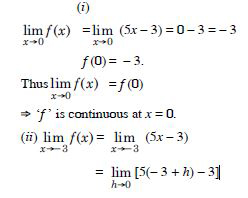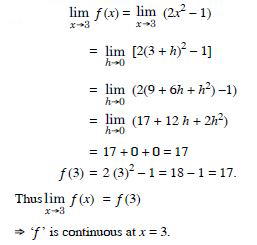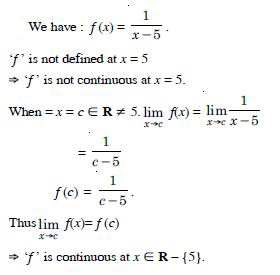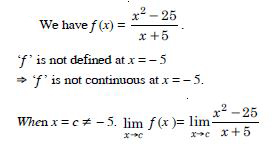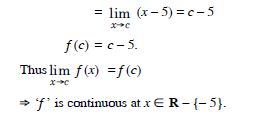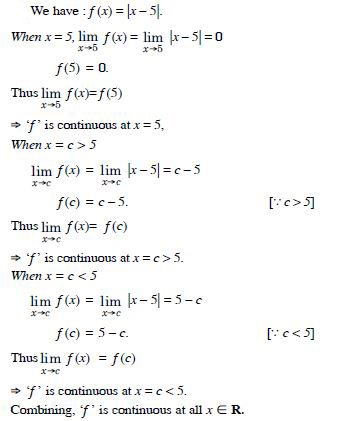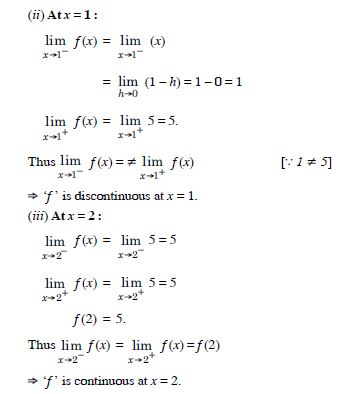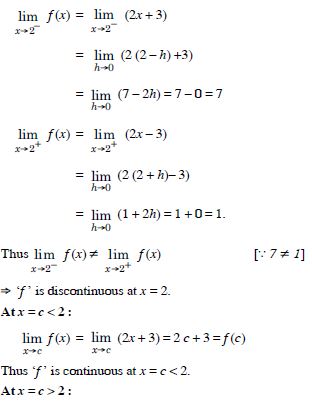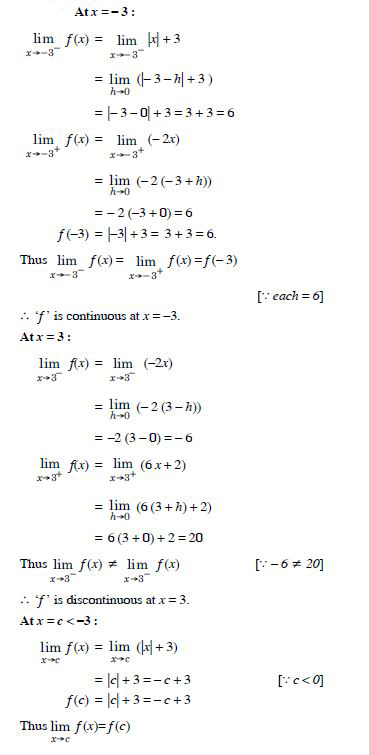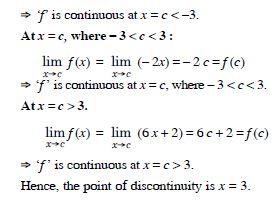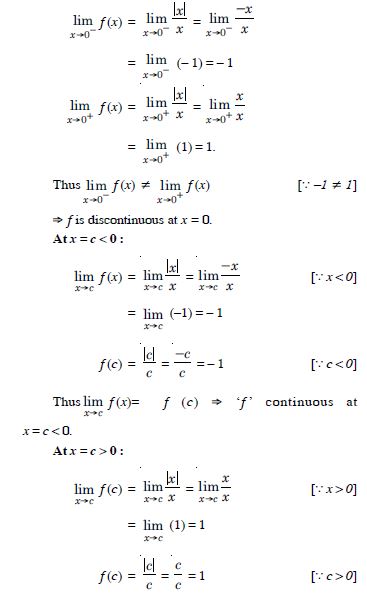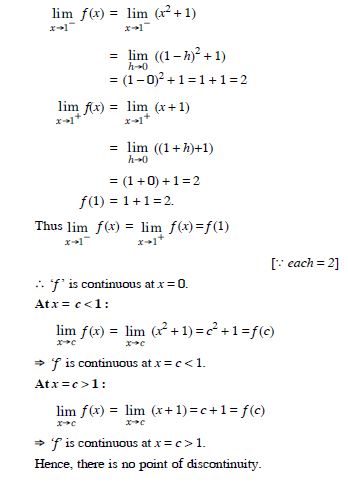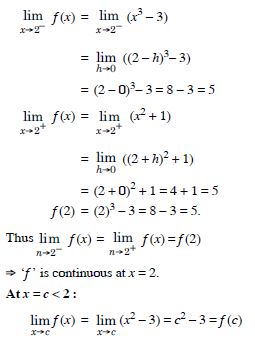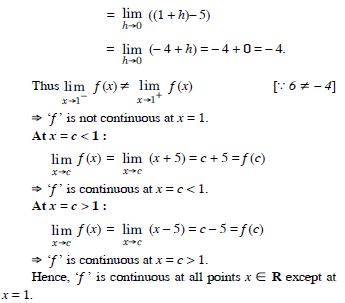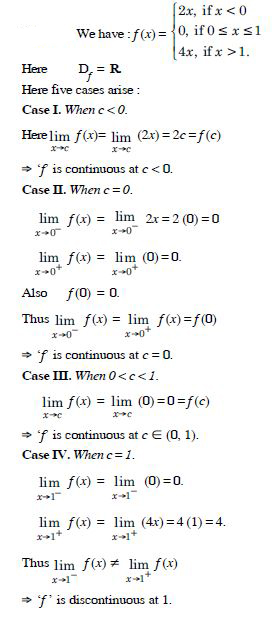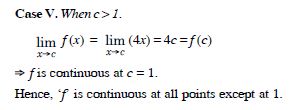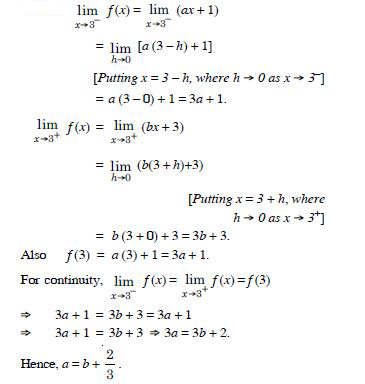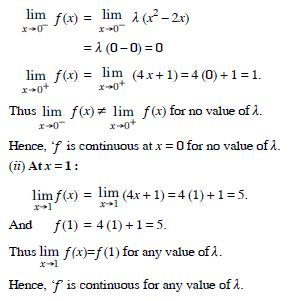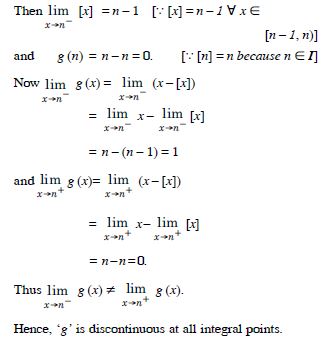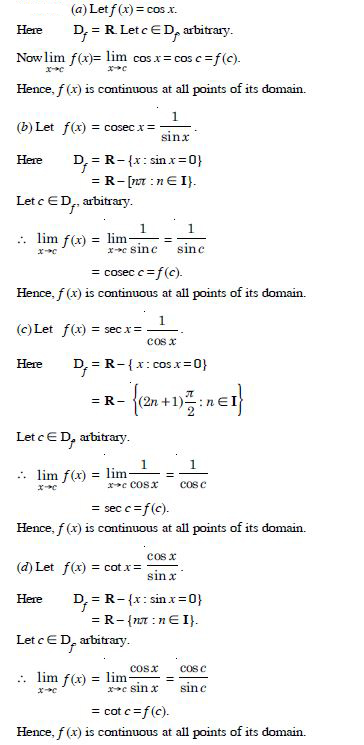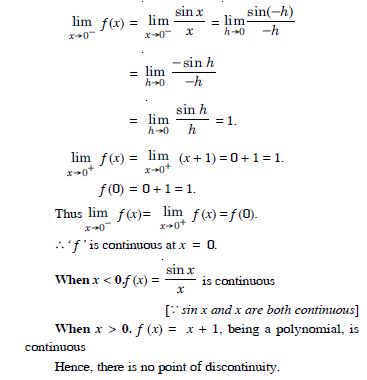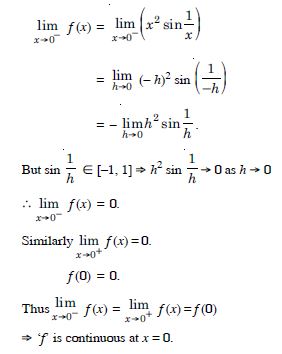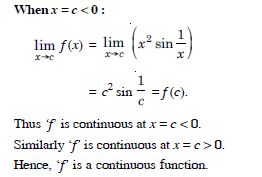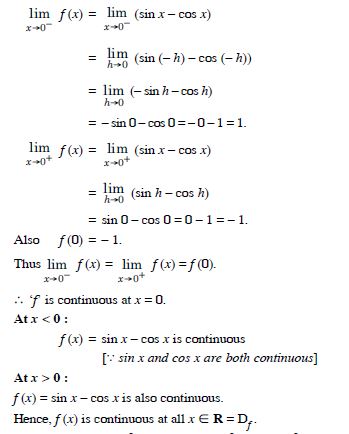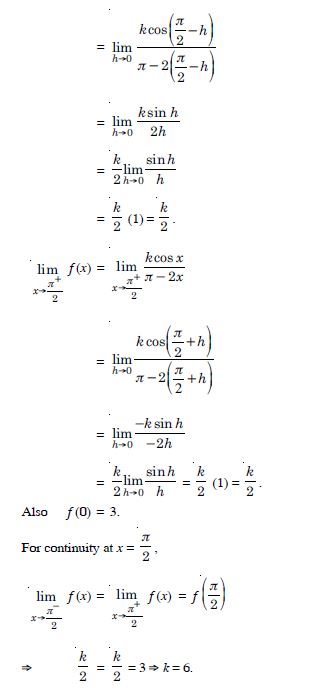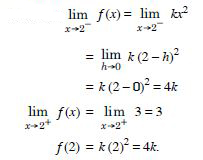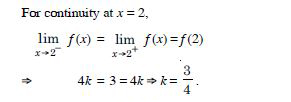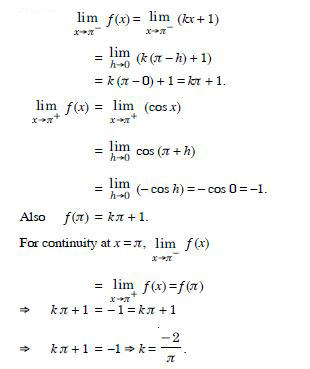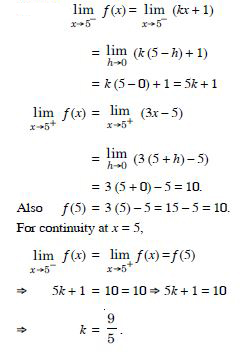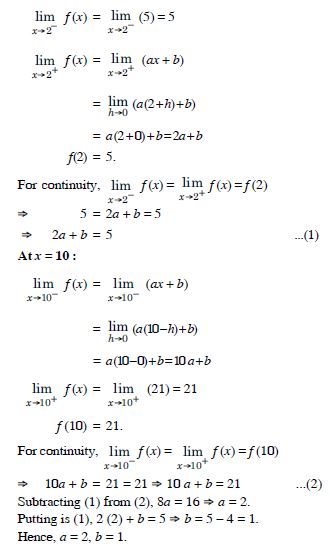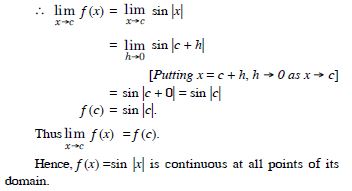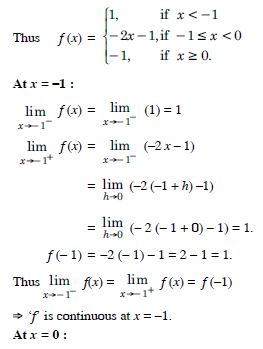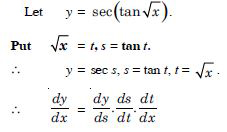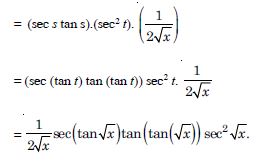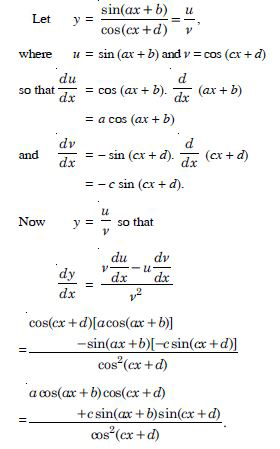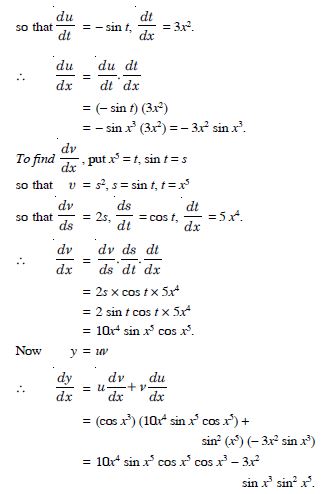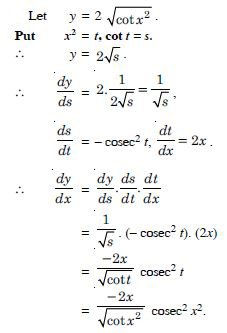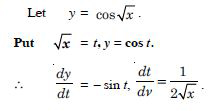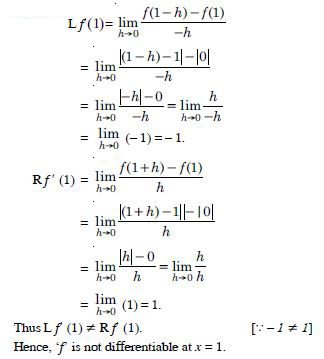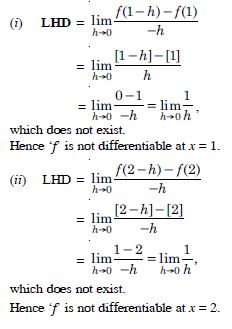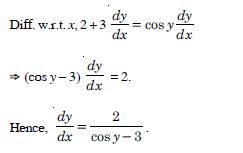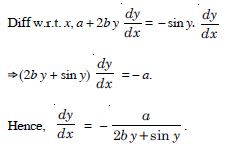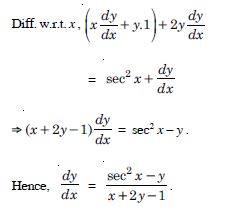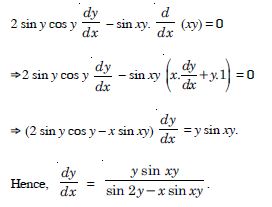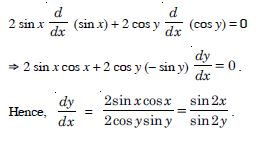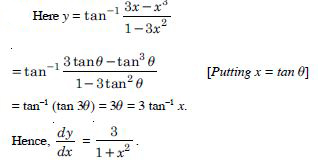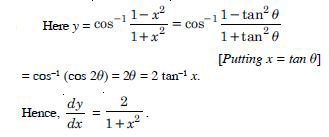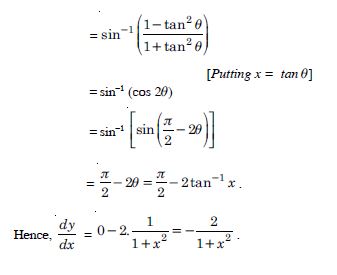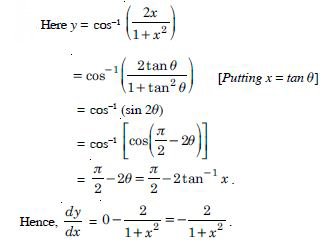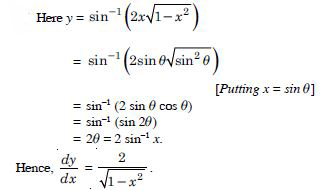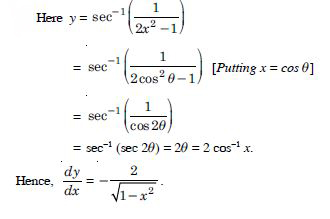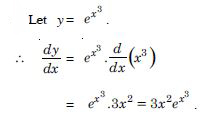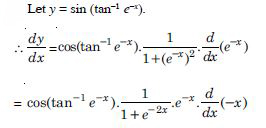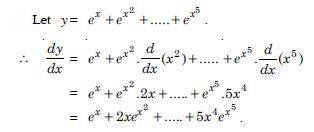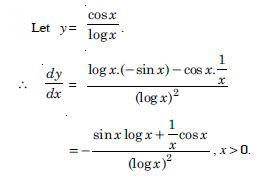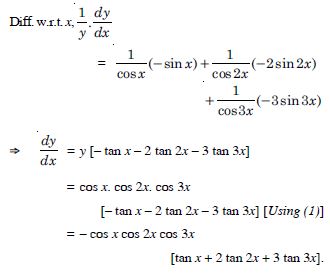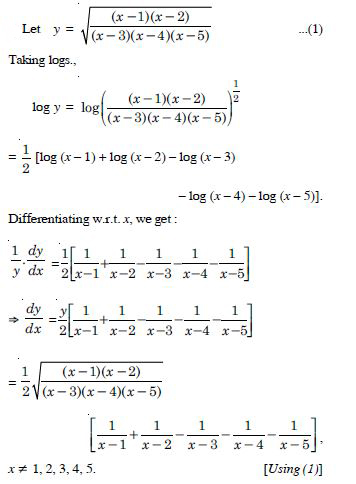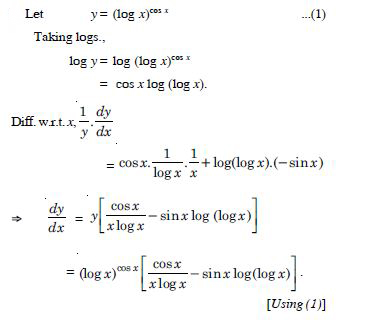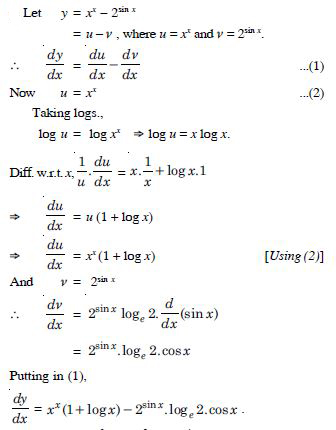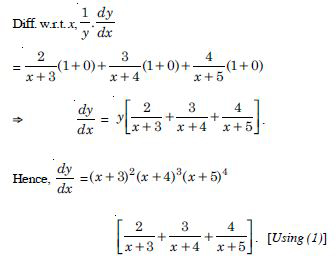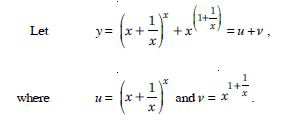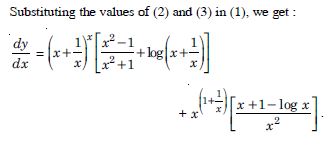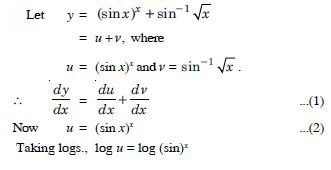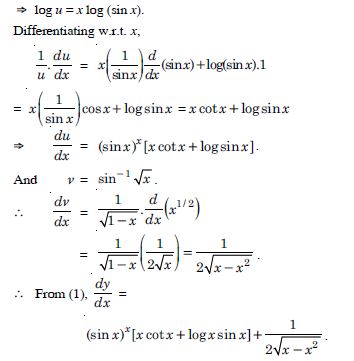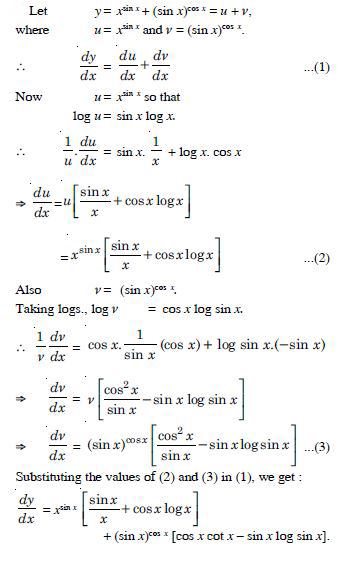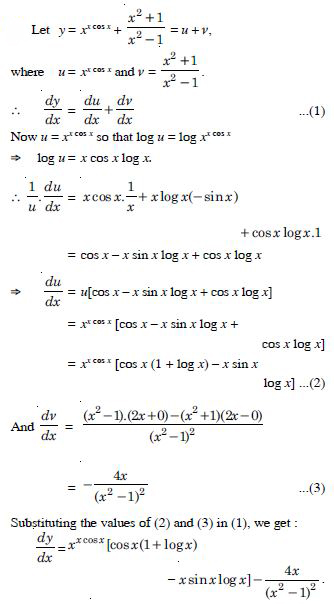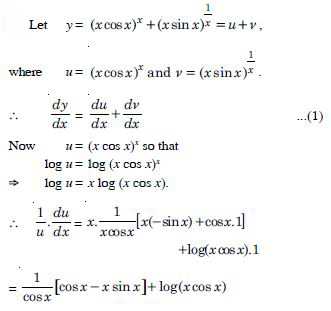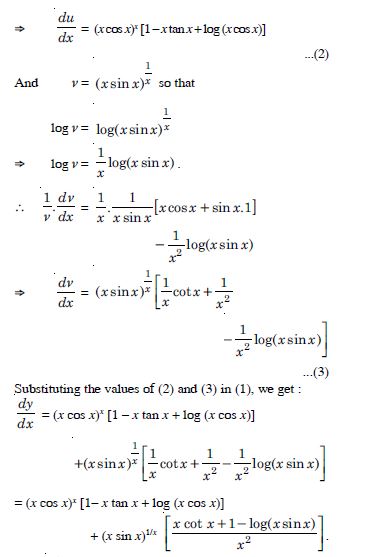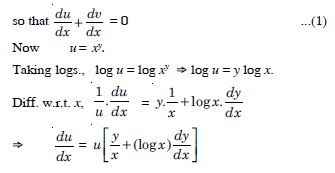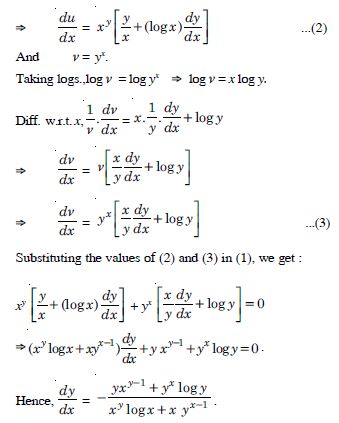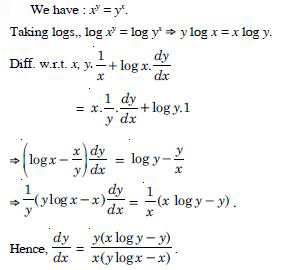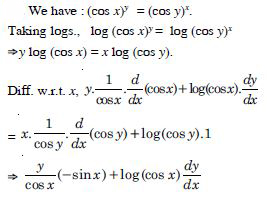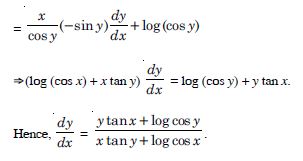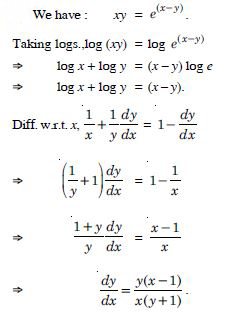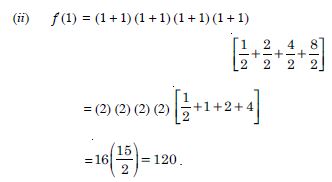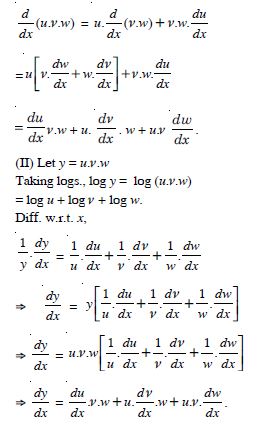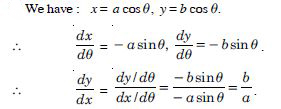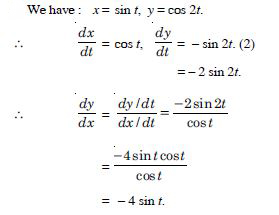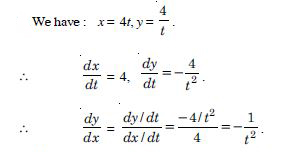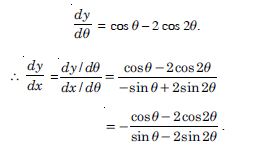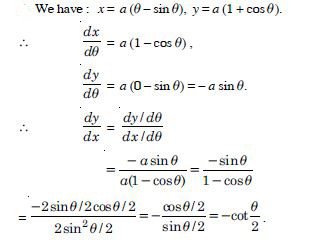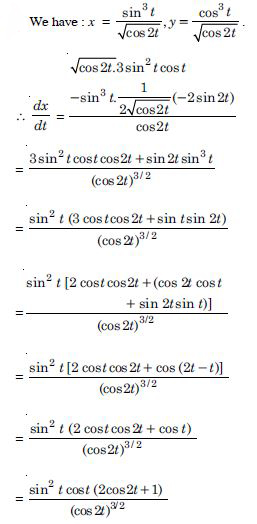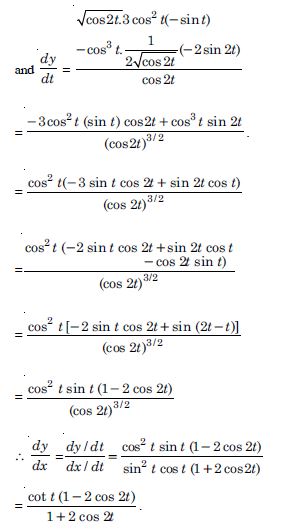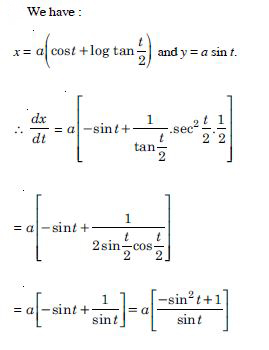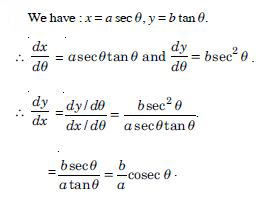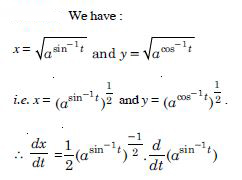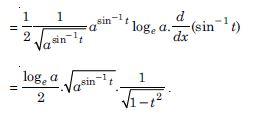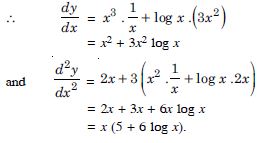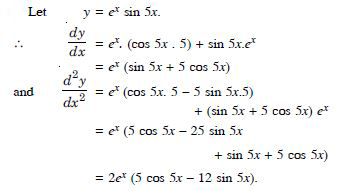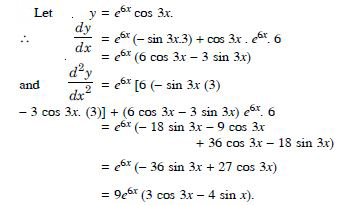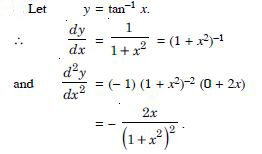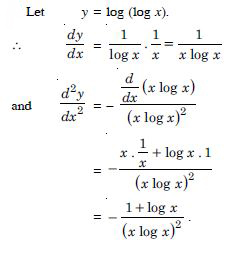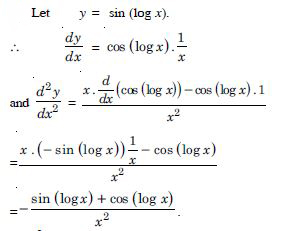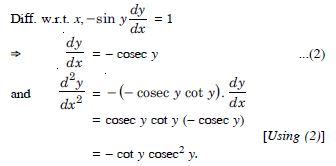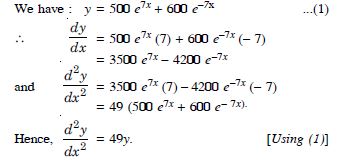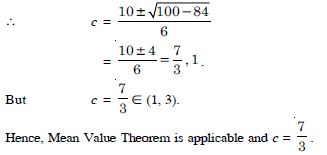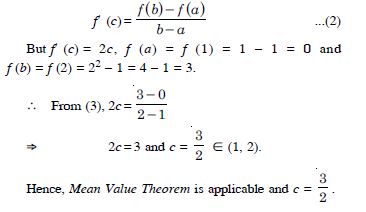Question 1:
Prove that the function f (x) = 5x – 3 is continuous at x = 0, at x = – 3 and at x = 5.
Answer:
Question 2:
Examine the continuity of the function f (x) = 2x2 – 1 at x = 3.
Answer:
Question 3:
Examine the following functions for continuity :
f (x) = x – 5
Answer:
Since f (x) = x – 5 is a polynomial,
‘f ’ is continuous at each x R.
Question 4:
Examine the following functions for continuity :
Answer:
Question 5:
Examine the following functions for continuity :
Answer:
Question 6:
Examine the following functions for continuity :
f (x) = | x – 5|.
Answer:
Question 7:
Prove that the function f (x) = xn is continuous at x = n, where n is a positive integer.
Answer:
Since f (x) = xn is a polynomial,
it is continuous at all n R.
Hence ‘f ’ is continuous at x = n N.
Question 8:
Is the function ‘f ’ defined by :
continuous at x = 0 ? At x = 1 ? At x = 2 ?
Answer:
Question 9:
Find all points of discontinuity of ‘f ’, where ‘f ’ is defined by
Answer:
At x = 2 :
Question 10:
Find all points of discontinuity of ‘f ’, where ‘f ’ is defined by
Answer:
Question 11:
Find all points of discontinuity of ‘f ’, where ‘f ’ is defined by
Answer:
At x = 0 :
Question 12:
Find all points of discontinuity of ‘f ’, where ‘f ’ is defined by
Answer:
At x = 0 :
Question 13:
Find all points of discontinuity of ‘f ’, where ‘f ’ is defined by
Answer:
At x = 1 :
Question 14:
Find all points of discontinuity of ‘f ’, where ‘f ’ is defined by
Answer:
At x = 2 :
Question 15:
Find all points of discontinuity of ‘f ’, where ‘f ’ is defined by
Answer:
At x = 1 :
Question 16:
Is the function defined by :
a continuous function ?
Answer:
At x = 1.
Question 17:
Discuss the continuity of the function ‘f ’, where ‘f ’ is defined by
Answer:
Question 18:
Discuss the continuity of the function ‘f ’, where ‘f ’ is defined by
Answer:
Question 19:
Discuss the continuity of the function ‘f ’, where ‘f ’ is defined by
Answer:
Here Df = R.
Here five cases arise :
Case I. Where c < –1.
Question 20:
Find the relationship between ‘a’ and ‘b’ so that the function ‘f ’ defined by :
is continuous at x = 3.
Answer:
Question 21:
For what value of is the function :
What about continuity at x = 1 ?
Answer:
At x = 0 :
Question 22:
Show that the function defined by g (x) = x – [x] is discontinuous at all integral points.
Answer:
Let n I.
Question 22:
Is the function defined by
f (x) = x2 – sin x + 5 continuous at x = ?
Answer:
We have : f (x) = x2 – sin x + 5.
f () = 2 – sin + 5 = 2 – 0 + 5
= 2 + 5.
= 2 – sin + 5
=2 – 0 + 5 = 2 + 5 = f ().
Hence, ‘f’ is continuous at x = .
Question 24:
Discuss the continuity of the following functions :
(a) f (x) = sin x + cos x
(b) f (x) = sin x – cos x
(c) f (x) = sin x . cos x.
Answer:
(a) We have :
f (x) = sin + cos x, Df = R.
Let c Df.
= sin c + cos c = f (c)
‘f’ is continuous at x = c.
But c is arbitrary.
Hence, ‘f’ is a continuous function.
(b) Replace (+) by (–).
(c) Replace (+) by (.).
Question 25:
Discuss the continuity of the cosine, cosecant, secant and cotangent functions.
Answer:
Question 26:
Find all points of discontinuity of f, where :
Answer:
At x = 0 :
Question 27:
Determine if ‘f’ defined by :
is a continuous function.
Answer:
At x = 0 :
Question 28:
Examine the continuity of ‘f ’, where ‘f ’ is defined by :
Answer:
At x = 0 :
Question 29:
Find the values of k so that the function ‘f’ is continuous at the indicated point in
Answer:
Question 30:
Find the values of k so that the function ‘f’ is continuous at the indicated point in
Answer:
Question 31:
Find the values of k so that the function ‘f’ is continuous at the indicated point in
Answer:
Question 32:
Find the values of k so that the function ‘f’ is continuous at the indicated point in
Answer:
Question 33:
Find the values of a and b such that the function defined by :
is a continuous function.
Answer:
Since f is continuous at all x,
f is continuous at x = 2, 10.
At x = 2 :
Question 34:
Show that the function defined by f (x) = cos (x2) is a continuous function.
Answer:
We have : f (x) = cos (x2).
Df= R.
Let c Df, arbitrary.
‘f’ is continuous at x = c
‘f’ is continuous on R.
Question 35:
Show that the function defined by f (x) = |cos x| is a continuous function.
Answer:
We have : f (x) = |cosx|.
Df = R.
Let c Df, arbitrary.
‘f’ is continuous at x = c
‘f’ is continuous on R.
Question 36:
Show that sin |x| is a continuous function.
Answer:
We have : f (x) = sin |x|.
Let c be an arbitrary number Df.
Question 37:
Find all the points of discontinuity of ‘f’ defined by f (x) = |x| – |x + 1|.
Answer:
We have : f (x) = |x| – |x + 1|.
‘f’ is continuous at x = 0
Also ‘f ’ being constant, is continuous when x < –1 or
when x > 0.
Thus ‘f’ is continuous for all x R.
Hence, there is no point of discontinuity.
Question 38:
Differentiate the following functions with respect to x sin (x2 + 5)
Answer:
Let y = sin (x2 + 5).
Put x2 + 5 = t.
y = sin t, where t = x2 + 5.
= cos t. (2x + 0) = 2x cos (x2 + 5).
Question 39:
Differentiate the following functions with respect to x cos (sin x)
Answer:
Let y = cos (sin x).
Put sin x = t.
y = cos t, where t = sin x.
= (– sin t).(cos x)
= – [sin (sin x)] cos x.
Question 40:
Differentiate the following functions with respect to x sin (ax + b)
Answer:
Let y = sin (ax + b).
Put ax + b = t.
y = sin t, where t = ax + b.
= a cos (ax + b).
Question 41:
Differentiate the following functions with respect to x
Answer:
Question 42:
Differentiate the following functions with respect to x
Answer:
Question 43:
Differentiate the following functions with respect to x cos x3. sin2 (x5)
Answer:
Let y = cos x3.sin2 (x5) = uν,
where u = cos x3 and ν = sin2 (x5).
Question 44:
Differentiate the following functions with respect to x
Answer:
Question 45:
Differentiate the following functions with respect to x
Answer:
Question 46:
Prove the function ‘f’ given by :
f (x) = |x – 1|, x R
is not differentiable at x = 1.
Answer:
Question 47:
Prove that the greatest integer function defined by [x], 0 < x < 3 is not differentiable at x = 1 and x = 2.
Answer:
Let f (x) = [x].
Question 48:
2x + 3y = sin x
Answer:
We have : 2x + 3y = sin x.
Question 49:
2x + 3y = sin y
Answer:
We have : 2x + 3y = sin y.
Question 50:
ax + by2 = cos y
Answer:
We have : ax + by2 = cos y.
Question 51:
xy + y2 = tan x + y
Answer:
We have : xy + y2 = tan x + y.
Question 52:
x2 + xy + y2 = 100
Answer:
We have : x2 + xy + y2 = 100.
Question 53:
x3 + x2y + xy2 + y3 = 81
Answer:
We have : x3 + x2y + xy2 + y3 = 81.
Question 54:
sin2 y + cos xy =
Answer:
We have : sin2 y + cos xy = .
Diff. w.r.t. x,
Question 55:
sin2 x + cos2 y = 1.
Answer:
We have : sin2 x + cos2 y = 1.
Diff. w.r.t. x,
Question 56:
Answer:
Question 57:
Answer:
Question 58:
Answer:
Question 59:
Answer:
Question 60:
Answer:
Question 61:
Answer:
Question 62:
Answer:
Question 63:
Differentiate the following w.r.t. x :
Answer:
Question 64:
Differentiate the following w.r.t. x :
Answer:
Question 65:
Differentiate the following w.r.t. x :
Answer:
Question 66:
Differentiate the following w.r.t. x :
sin (tan–1 e–x
Answer:
Question 67:
Differentiate the following w.r.t. x :
log (cos ex)
Answer:
Question 68:
Differentiate the following w.r.t. x :
Answer:
Question 69:
Differentiate the following w.r.t. x :
Answer:
Question 70:
Differentiate the following w.r.t. x :
log (log x), x > 1
Answer:
Question 71:
Differentiate the following w.r.t. x :
Answer:
Question 72:
Differentiate the following w.r.t. x :
cos (log x + ex), x > 0.
Answer:
Question 73:
Differentiate the functions given in w.r.t. x :
cos x. cos 2x. cos 3x.
Answer:
Let y = cos x.cos 2x.cos 3x.
Taking logs.,
log y = log (cos x. cos 2x.cos 3x) ...(1)
= log cos x + log cos 2x + log cos 3x.
Question 74:
Differentiate the functions given in w.r.t. x :
Answer:
Question 75:
Differentiate the functions given in w.r.t. x :
(log x)cos x.
Answer:
Question 76:
Differentiate the functions given in w.r.t. x :
xx – 2sin x
Answer:
Question 77:
Differentiate the functions given in w.r.t. x :
(x + 3)2.(x + 4)3.(x + 5)4.
Answer:
Let y = (x + 3)2 (x + 4)3 (x + 5)4 ...(1)
Taking logs., log y = log (x + 3)2 (x + 4)3(x + 5)4
= 2 log (x + 3) + 3 log (x + 4) + 4 log (x + 5).
Question 78:
Differentiate the functions given in w.r.t. x :
Answer:
Question 79:
Differentiate the functions given in w.r.t. x :
(log x )x + xlog x
Answer:
Question 80:
Differentiate the functions given in w.r.t. x :
Answer:
Question 81:
Differentiate the functions given in w.r.t. x :
xsin x + (sin x)cosx
Answer:
Question 82:
Differentiate the functions given in w.r.t. x :
Answer:
Question 83:
Differentiate the functions given in w.r.t. x :
Answer:
Question 84:
xy + yx = 1.
Answer:
We have : xy + yx = 1.
Putting xy = u and yx = ν, we get :
u + ν= 1
Question 85:
yx = xy.
Answer:
Question 86:
(cos x)y = (cos y)x.
Answer:
Question 87:
xy = e(x – y).
Answer:
Question 88:
Find the derivative of the function given by :
f (x) = (1 + x) (1 + x2) (1 + x4) (1 + x8) and hence find f ′ (1).
Answer:
(i) We have :
f(x) = (1 + x) (1 + x2) (1 + x4) (1 + x8) ...(1)
Taking logs., log f(x)
= log (1 + x) + log (1 + x2) + log (1 + x4) + log (1 + x8).
Question 89:
Differentiate (x2 – 5x + 8) (x3 + 7x + 9) in three ways
mentioned below :
(i) by using product rule
(ii) by expanding the product to obtain a single polynomial
(iii) by logarithmic differentiation.
Do they give the same answer ?
Answer:
We have :
f(x) = (x2 – 5x + 8) (x3 + 7x + 9) ...(1)
(i) By Product Rule :
= (x2 – 5x + 8) (3x2 + 7)
+ (x3 + 7x + 9) (2x – 5)
= 3x4 –15x3 + 24x2 + 7x2 – 35x + 56 + 2x4
+ 14x2 + 18x – 5x3 – 35x – 45
= 5x4 – 20x3 + 45x2 – 52x + 11.
(ii) By Expansion :
f(x) = x5 + 7x3 + 9x2 – 5x4 – 35x2 – 45x
+ 8x3 + 56x + 72
= x5 – 5x4 + 15x3 – 26x2 + 11x + 72.
f′(x) = 5x4 – 20x3 + 45x2 – 52x + 11.
(iii) By Logarithmic Differentiation :
Taking logs., on both sides of (1),
log f (x) = log (x2 – 5x + 8) (x3 + 7x + 9)
= log (x2 – 5x + 8) + log (x3 + 7x + 9).
= (2x – 5) (x3 + 7x + 8) + (3x2 + 7) (x2 – 5x + 8)
= 5x4 – 20x3 + 45x2 – 52x + 11.
Hence, the three answers are the same.
Question 90:
If u, ν, w are differentiable functions of x, then show that :
in two ways by repeated application of product rule, second by logarithmic differentiation.
Answer:
Question 91:
If x and y are connected parametrically by the equations given below without eliminating the parameters.
x = 2at2, y = at4.
Answer:
Question 92:
If x and y are connected parametrically by the equations given below without eliminating the parameters.
x = a cos , y = b cos .
Answer:
Question 93:
If x and y are connected parametrically by the equations given below without eliminating the parameters.
x = sin t, y = cos 2t.
Answer:
Question 94:
If x and y are connected parametrically by the equations given below without eliminating the parameters.
Answer:
Question 95:
If x and y are connected parametrically by the equations given below without eliminating the parameters.
x = cos – cos 2, y = sin – sin 2.
Answer:
Question 96:
If x and y are connected parametrically by the equations given below without eliminating the parameters.
x = a ( – sin ), y = a (1 + cos ).
Answer:
Question 97:
If x and y are connected parametrically by the equations given below without eliminating the parameters.
Answer:
Question 98:
If x and y are connected parametrically by the equations given in without eliminating the parameters.
Answer:
Question 99:
If x and y are connected parametrically by the equations given in without eliminating the parameters.
x = a sec , y = b tan .
Answer:
Question 100:
If x and y are connected parametrically by the equations given in without eliminating the parameters.
x = a (cos + sin ), y = a (sin – cos ).
Answer:
Question 101:
Answer:
Question 102:
Find the second order derivative of the functions given in x2 + 3x + 2
Answer:
Let y = x2 + 3x + 2.
Question 103:
Find the second order derivative of the functions given in x20
Answer:
Let y = x20.
Question 104:
Find the second order derivative of the functions given in x cos x
Answer:
Let y = x cos x.
Question 105:
Find the second order derivative of the functions given in log x
Answer:
Let y = log x.
Question 106:
Find the second order derivative of the functions given in x3 log x
Answer:
Let y = x3 log x.
Question 107:
Find the second order derivative of the functions given in ex sin 5x
Answer:
Question 108:
Find the second order derivative of the functions given in e6x cos 3x
Answer:
Question 109:
Find the second order derivative of the functions given in tan–1 x
Answer:
Question 110:
Find the second order derivative of the functions given in log (log x)
Answer:
Question 111:
Find the second order derivative of the functions given in sin (log x).
Answer:
Question 112:
If = 5 cos x – 3 sin x, prove that :
Answer:
We have : y = 5 cos x – 3 sin x ...(1)
Question 113:
Answer:
We have :
y = cos–1 x
cos y = x ...(1)
Question 114:
If y = 3 cos (log x) + 4 sin (log x), show that :
x2y2 + y1 + y = 0.
Answer:
x2y2 + xy1 = – (3 cos (log x) + 4 sin (log x))
= – y. [Using (1)]
Hence, x2y2 + xy1 + y = 0.
Question 115:
If y = A emx + B enx, show that :
Answer:
Question 116:
If y = 500 e7x + 600 e–7xm, show that :
Answer:
Question 117:
If ey (x + 1) = 1, show that :
Answer:
We have : ey (x + 1) = 1
Question 118:
If y = (tan–1 x)2, show that :
(x2 + 1)2 y2 + 2x (x2 + 1) y1 = 2.
Answer:
We have : y = (tan–1 x)2 ...(1)
Question 119:
Verify Rolle’s theorem for the function :
f (x) = x2 + 2x – 8, x [– 4, 2].
Answer:
We have : f (x) = x2 + 2x – 8.
(I) f (x) is continuous in [– 4, 2].
[ f (x) is a polynomial in x]
(II) f′ (x) = 2x + 2 ...(1)
f′ (x) exists for each x (– 4, 2).
(III) f (– 4) = (– 4)2 + 2 (– 4) – 8
= 16 – 8 – 8 = 0,
f (2) = (2)2 + 2 (2) – 8
= 4 + 4 – 8 = 0.
f (– 4) = f (2).
Thus all the conditions of Rolle’s Theorem are satisfied.
There exists at least one number ‘c’ between – 4 and 2
s.t. f′ (c) = 0.
But f′ (c) =2c + 2 [Putting x = c in (1)]
f′ (c) = 0 gives 2c + 2 = 0
c = – 1 (– 4, 2).
Hence, the theorem is verified and c = – 1.
Question 120:
Examine if Rolle’s theorem is applicable to any of the following functions. Can you say something about the
converse of Rolle’s theorem from these examples ?
(i) f (x) = [x] for x [5, 9]
(ii) f (x) = [x] for x [– 2, 2]
(iii) f (x) = x2 – 1 for x [1, 2].
Answer:
(a) (i) We have :
f (x) = [x] for x [5, 9].
f(x) is neither continuous nor derivable at x = 6, 7, 8.
Hence, Rolle’s Theorem is not applicable.
(ii) We have f (x) = [x] for x [– 2, 2].
f (x) is neither continuous nor derivable at
x = – 1, 0, 1.
Hence, Rolle’s theorem is not applicable.
(iii) We have : f (x) = x2 – 1 for x [1, 2].
(I) f (x) is continuous in [1, 2].
[ f (x) is a polynomial in x]
(II) f′ (x) = 2x, which exists in (1, 2)
f (x) is derivable in (1, 2).
(III) f (1) = 1 – 1 = 0, f (2) = 4 – 1 = 3
f (1) f (2).
Hence, Rolle’s Theorem is not applicable.
(b) Conversely :
If f′ (c) = 0, c [a, b], the conditions of Rolle’s theorem
are not true.
Question 121:
If f : [– 5, 5] R is differentiable function and if f′ (x) does not vanish anywhere, then prove that f (– 5) f (5).
Answer:
Let us assume that f (– 5) = f (5).
Then ‘f’ satisfies all the conditions of Rolle’s Theorem in
[– 5, 5].
[ Differentiability Continuity]
Then there must exist at least one c (– 5, 5) such that
f′ (c) = 0.
Thus our supposition is wrong.
Hence, f (– 5) f (5).
Question 122:
Verify Mean Value Theorem. if f (x) = x2 – 4x – 3 in the interval [a, b], where a = 1 and b = 4.
Answer:
Solution. We have :
f (x) = x2 – 4x – 3 ...(1)
(I) f (x) is continuous in [1, 4].
[ f (x) is a polynomial in x]
(II) f′ (x) = 2x – 4 ...(2)
Thus f′ (x) exists for each x in (1, 4).
Thus both the conditions of Mean Value Theorem are
satisfied.
There exists at least one number ‘c’ between a and b
But f′(c) = 2c – 4 [Putting x = c in (2)]
f (a) = f (1) = 1 – 4 – 3 = – 6
f (b) = f (4) = 16 – 16 – 3 = – 3.
2c – 4 = 1
2c = 5
Question 123:
Verify Mean Value Theorem if :
f (x) = x3 – 5x2 – 3x in the interval [a, b], where
a = 1 and b = 3. Find all c (1, 3) for which f ′(c) = 0.
Answer:
(i) We have :
f (x) = x3 – 5x2 – 3x ...(1)
(I) Since f (x) is a polynomial in x,
it is continuous in [1, 3].
(II) f′ (x) = 3x2 – 10x – 3 ...(2),
which exists in (1, 3).
Thus both the conditions of Mean Value Theorem are
satisfied.
There exists at least one point ‘c’ in (1, 3) such that :
But f′ (c) = 3c2 – 10c – 3,
f (a) = f (1) = 1 – 5 – 3 = – 7
and f (b) = f (3) = 27 – 5 (9) – 3 (3)
= 27 – 45 – 9 = – 27.
3c2 – 10c – 3 = – 10
3c2 – 10c + 7 = 0.
Question 124:
Examine the applicability of Mean Value Theorem
for the following functions :
(i) f (x) = [x] for x [5, 9]
(ii) f (x) = [x] for x [– 2, 2]
(iii) f (x) = x2 – 1 for x [1, 2].
Answer:
(i) We have : f (x) = [x] ; x [5, 9].
Clearly f (x) is neither continuous nor derivable at integral
points of the interval [5, 9],
i.e. at x = 5, 6, 7, 8 and 9.
Thus f (x) is neither continuous in [5, 9] nor derivable in
(5, 9).
Hence, Mean Value Theorem is not applicable to f (x) in
[5, 9].
(ii) We have : f (x) = [x], x [– 2, 2].
Clearly f (x) is neither continuous nor derivable. at
x = – 2, – 1, 0, 1, 2.
Thus f (x) is neither continuous in [– 2, 2] nor derivable
in (– 2, 2).
Hence, Mean value Theorem is not applicable to f (x) in
[– 2, 2].
(iii) We have f (x) = x2 – 1.
It is continuous in [1, 2].
[ f (x) is a polynomial in x]
(II) f′ (x) = 2x, which exists in (1, 2).
Thus both the conditions of Mean Value Theorem are
satisfied.
There exists at least one point ‘c’ in (1, 2) such that :
Question 125:
continuous at x = 0, then the value of ‘k’ is:
- 3
- 2
- 1
- 1.5
Answer:
2
Question 126:
The function f(x) = [x], where [x] denotes the greatest integer function, is continuous at :
- 4
- –2
- 1
- 1.5
Answer:
1.5
Question 127:
The value of ‘k’ which makes the function defined by :
continuous at x = 0 is :
- 8
- 3
- –1
- None of these
Answer:
None of these
Question 128:
Differential coefficient of sec (tan–1 x) w.r.t. x is :
Answer:
Question 129:
Answer:
Question 130:
Answer:
Question 131:
- x
- 1
Answer:
1
Question 132:
Answer:
Question 133:
- 1
- -1
Answer:
1
Question 134:
The value of ‘c’ in Mean Value Theorem for the function f(x) = x (x – 2), x [1, 2] is :

